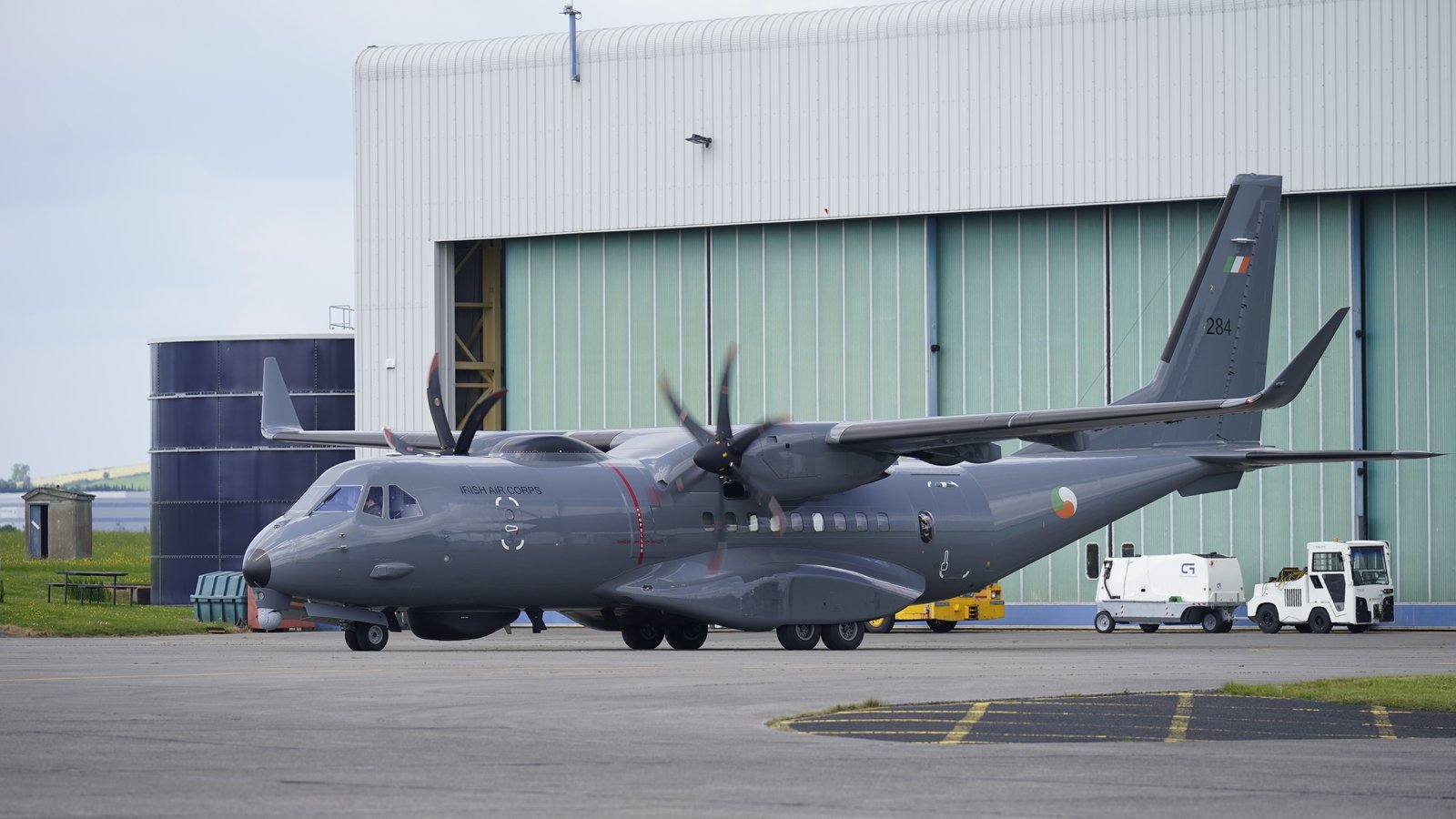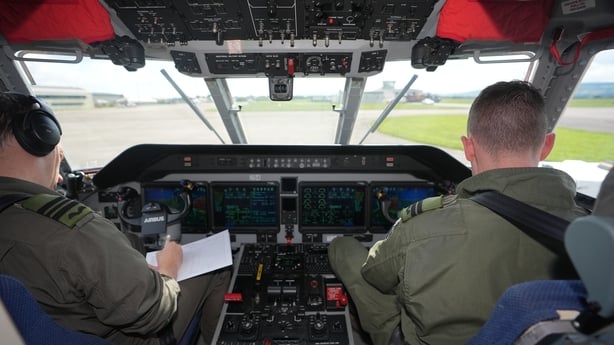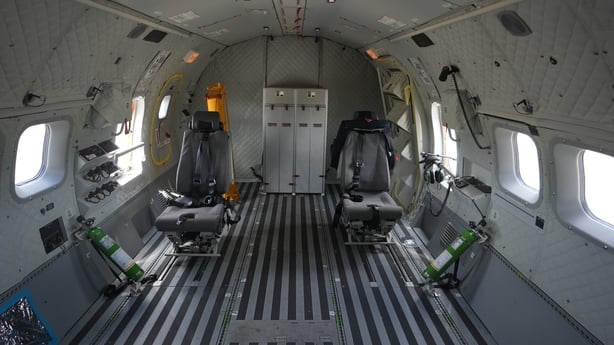World
Sky’s not the limit for ambitious new Irish Air Force

The Irish Air Corps is preparing for a radical transformation that in the next decade could see it operating combat jets once again.
The foundation stones for the new ‘Irish Air Force’ are being laid as we speak.
The Air Corps, which we’ve known as Ireland’s military wing in the skies, is preparing for a radical transformation that could see it operating combat jets once again in defence of the State.
It will be changing its name to Air Force and changing how it operates as a stand-alone branch of Ireland’s Defence Forces.
All of this was outlined in the Commission on the Defence Forces which was published in 2023, with a timeline of sometime around 2027 when the Irish Air Force will start being put into operation as a stand alone service.
At an equipment level, that is already under way.
Speaking at the Air Corps Casement headquarters this week, the Defence Forces’ Chief of Staff Lieutenant General Sean Clancy said: “We’ve always had an extraordinary air force, if I can put it that way, we’ve called it the Air Corps, but as you know, that 10-year plan is to grow it to an air force.
“We’ve moved with technology, we’ve been leaders with technology, right from the days when we brought in the search and rescue back in the 60s,” he said.
This week they opened up what is probably the most sophisticated and advanced aircraft they’ve ever operated for media scrutiny.
The Airbus C295 is one of a pair that will be used to carry out covert and overt missions along with search and rescue, aid for troops, and Irish citizens in danger overseas.
Equipped with the latest computer systems that can zoom in on a car registration plate from 15,000 feet up, it can also fly thousands of kilometres and remain aloft for up to 11 hours, taking up to 50 people to safety if needed.
Its multitude of sensors and communications devices can track boats and ships around our coast from a distance, and help direct helicopter crews and Army Ranger wing teams to where they are needed.

The aircraft are part of a €200m purchase from Airbus Casa, with a third being absent of expensive radar and cameras so it can be dedicated to transport and logistics role.
That C295 will be dispatched to trouble spots around the world on mercy missions, and all three are equipped with defensive systems if shot at or if missiles are fired at them.
These, along with a squadron of four PC12 Spectre utility aircraft, which are also recent acquisitions, will build the Air Corps and its personnel up to what will be the new ‘Irish Air Force’ in the decades to come.
There will be new helicopters to move troops around in the next couple of years too.
It’s worth remembering, all the above aircraft can, and do, double as air ambulance services.
However, it will be more than just a name change, and the Commission on the Defence Forces made that clear when it made this recommendation, which has been adopted by the Government.
It will separate the Air Corps from an effective sub branch of the army, with a stand-alone command and decision-making structure.
In terms of headline grabbing, whoever is in government in 2028, will be left to make a decision about a return of combat jets to Baldonnel, including how many and what type.
Combat jets are not new to the Air Corps. De Havilland Vampire fighters in the T11 configuration were flown by then No 1 fighter squadron until the mid 70s.
They were replaced with less able, but well loved, Fouga Magister ground attack jets, retired at the end of the 90s.
This will all be backed up by long-awaited military radar. For the first time, radar will give Ireland military grade eyes across the nation’s skies, picking up everything from drones to suspicious aircraft.

That project is already under way, and a team are tasked with researching similar systems worldwide, with 2028 seen as the magic date for its introduction.
Lt Gen Clancy said the C295 aircraft “are part of the overall jigsaw” to monitor threats that exist in Ireland’s maritime domain from drug cartels to people and weapons smugglers, adding “these resources, but more importantly the human resources to operate them and their capacities” would really be the step change.
In terms of acquiring air policing or combats jets, he underlined “that is a decision that will come in LOA3” or Level of Ambition 3 as outlined by the Commission. This is the post-2028 period.
He also referenced Ireland’s inability to monitor what is happening below our territorial waters, i.e. submarine activity, saying “our maritime domain is 10 times greater than our land mass in terms of EEZ [Exclusive Economic Zone], it’s the third largest in Europe”.
“It’s very clear we don’t have any subsurface capacity at this time, and it’s something of course, we will look to in the future, it’s part of the plan in terms of the high-level action plan in terms of LOA3, if you like, and that’s into the future,” said Lt Gen Clancy, adding that no single nation in Europe has the capacity to counter that threat.
Many Commission recommendations already being implemented
In the meantime, many recommendations from the Commission on the Defence Forces are already being implemented through the high-level action plan that followed.
Especially with what were seen as immediate ones to deal with the elephant in the room – the droves of personnel who have left and the reluctance of new recruits to join.
Published in 2022, the report on the Commission on the Defence Forces set out multiple changes needed. A detailed implementation plan was published last November and so far officials say over 130 actions have already been completed.
LOA2, for instance, calls for defence spending to increase to €1.5bn to support Ireland’s historically underfunded forces. It has already reached €1.23bn.
In line with the implementation timetable, representative groups RACO and PDFORRA will be allowed become full members of Irish Congress of Trade Unions (ICTU).

An external oversight body has been established to examine issues relating to allegations of discrimination, bullying, harassment and sexual harassment across the forces – with the legislation to place this on a statutory footing making its way through the houses of the Oireachtas.
One of the more important aspects for the soldiers, sailors and air crew is the adoption of the EU working time directive, which hitherto did not apply to the military, with claims being made going back years that extra hours worked were never properly logged.
Legislation allowing for this change is also making its way through the Oireachtas.
Pay scales have also been improved at entry level, with a starting salary of between €38,000 and €47,000 on offer for recruits and cadets.
There is a pledge to create family friendly policies, with new civilian appointments for head of strategic, human resources and a head of transformation being appointed. There are pledges on healthcare for staff and a veterans’ section for retired members.
An independent chair of the implementation oversight group is in place. That chair, Julie Sinnamon, has described the 2028 target for delivery of LOA2 as ambitious but said it is a “unique opportunity to deliver real change”.
Tánaiste and Minister for Defence Micheál Martin said the “threats to the rules-based international order” mean it has never been more important that Ireland has a well-equipped Defence Forces.
The Commission was set up because people were voting with their feet. While levels of ambition are now being worked on, the fact is Ireland’s military is at historic low levels of personnel. While it seems, everyone is in agreement that change simply must happen.
These plans will need a combined forces strength of at least 11,500 – a big jump from the 7,000 or so currently enlisted.
For now, the new C295s of the current Air Corps are fully operational as Ireland’s eyes in the sky.










